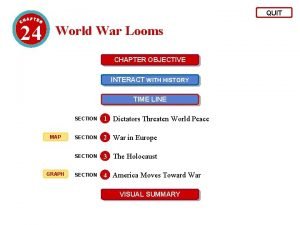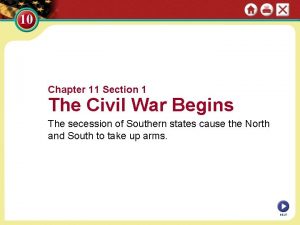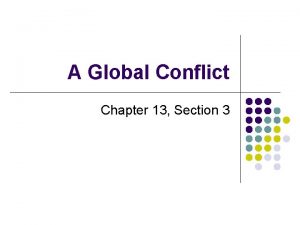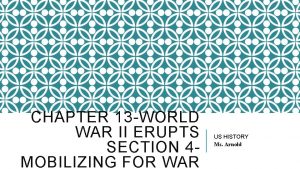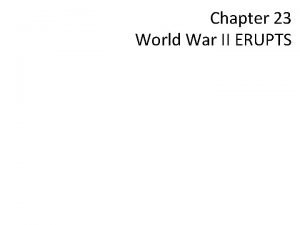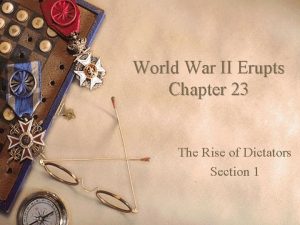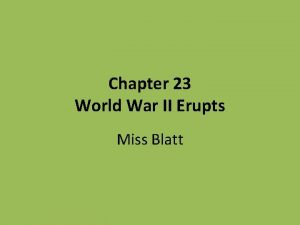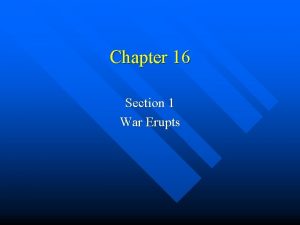CHAPTER 13 WORLD WAR II ERUPTS SECTION 2








- Slides: 8

CHAPTER 13 - WORLD WAR II ERUPTS SECTION 2 - EUROPE ERUPTS IN EUROPE US HISTORY Ms. Arnold

MAIN IDEA Far from being satisfied by the actions of France and Great Britain, Germany turned to force and triggered the start of World War II.

THE START OF WORLD WAR II Neville Chamberlain believed that his policy of appeasement—or giving in to aggressive demands to maintain peace— had prevented the outbreak of war. Rival British politician Winston Churchill condemned Chamberlain’s policy of appeasement and said it would lead to war. Churchill was correct; Hitler was not appeased by gaining the Sudentenland. In 1939 Hitler gained more land by force, made alliances that he hoped would help him in the future, and attacked Poland.

HITLER’S ACTIONS IN 1939 Czechoslovakia • In March Hitler sent troops into what remained of Czechoslovakia. • Czechoslovakia fell without putting up a fight. • Chamberlain finally realized that Hitler could not be trusted. • Appeasement had failed. Alliances • Established a pact with Italy • Established a nonaggression pact with Stalin’s Soviet Union • Stalin agreed not to stop Hitler’s expansion and Hitler agreed not to attack Stalin. • This pact shocked many in Europe.

POLAND • On September 1, 1939, Hitler invaded Poland. • The German military used the blitzkrieg, or “lightening war. ” • Poland fought back to no avail. • By the end of the month, Poland was in German hands.

GERMAN FORCES TURN TO THE WEST On September 3, 1939, Great Britain and France declared war on Germany. They became known as the Allies. The Allies did not attack Germany. Instead, they decided to wait for Germany to make its next move. They believed that Germany’s army would grow weak trying to invade France. Germany made plans to invade France through the Ardennes Forest. This was rugged terrain and the French army concentrated their defenses elsewhere. For example, the famed Maginot Line was to the south of the Ardennes.

GERMAN FORCES TURN TO THE April 1940 WEST Hitler invaded Denmark and Norway. May 1940 June 1940 This improved Germany’s access to the Atlantic. Both countries fell with little resistance. Germans invaded France. Germans conquered the Netherlands and stormed into Belgium. Belgian, British, and French troops tried to stop the Germans in Belgium. By early June the Germans had trapped hundreds of thousands of Allied soldiers at the French port of Dunkirk. Meanwhile, German forces attacked France through the Ardennes. The Maginot Line had been bypassed. France surrendered to Germany and Italy. The unoccupied part of France was known as Vichy France. Many French leaders, including Charles de Gaulle, fled to Great Britain to organize resistance to German and Vichy control of France.

INCREASING TENSIONS IN EAST ASIA 1934 Japan began expanding its naval forces despite promises made at the Washington Navel Conference. 1936 Japan signed an anticommunism pact with Germany. 1937 Japan began a war against China. 1940 Japan formed a military alliance with Germany and Italy. These nations were known as the Axis Powers. 1941 Japan moved to take control of French Indochina, which threatened American interests. President Roosevelt tried to reason with General Hideki Tojo, the minister of war who took control of the country in October of 1941. But the time for compromise was over.
 Chapter 18 volcanic activity
Chapter 18 volcanic activity If a laboratory fire erupts immediately
If a laboratory fire erupts immediately If a laboratory fire erupts, immediately
If a laboratory fire erupts, immediately Chapter 24 world war looms section 1 answers
Chapter 24 world war looms section 1 answers Chapter 24 world war looms section 1 answers
Chapter 24 world war looms section 1 answers Chapter 11 section 1 guided reading the civil war begins
Chapter 11 section 1 guided reading the civil war begins World war 1 begins chapter 11 section 1
World war 1 begins chapter 11 section 1 Chapter 13 section 3 war affects the world
Chapter 13 section 3 war affects the world Chapter 19 section 1 world war 1 begins
Chapter 19 section 1 world war 1 begins



